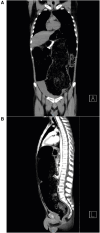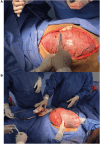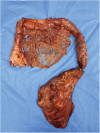Case Report: Toxic megacolon secondary to chronic constipation and cocaine consumption
- PMID: 39233765
- PMCID: PMC11371572
- DOI: 10.3389/fsurg.2024.1434523
Case Report: Toxic megacolon secondary to chronic constipation and cocaine consumption
Abstract
Toxic megacolon (TM) is a severe condition characterized by acute colonic dilation, with specific radiological and clinical signs. The multifactorial etiology of TM is primarily associated with inflammatory bowel disease and infections. However, TM remains a challenging complication due to its potential for rapid progression to life-threatening conditions. This report describes a rare case of TM in a 25-year-old male with a history of recurrent constipation and chronic cocaine consumption. Examination and imaging indicated acute intestinal obstruction with dilated colon segments and fecal impaction, necessitating an urgent laparotomy. Surgery revealed pan-colonic dilatation and sigmoid perforations, leading to a total colectomy and ileostomy. Chronic constipation, often perceived as benign, can escalate into a critical situation, possibly exacerbated by cocaine-induced muscle weakness and hypoxia. Evidence suggests that cocaine negatively affects the intestinal mucosa, potentially leading to ischemia. Chronic factors, including the use of enemas, may have contributed to megacolon development and perforation. Overall, this report underscores the critical elements of diagnosis and the importance of patients' medical history, particularly those with unusual risk profiles. In addition, it highlights the need for further research to fully understand the implications of these cases.
Keywords: bowel perforation; chronic constipation; cocaine abuse; total colectomy; toxic megacolon.
© 2024 Dimas, Hernández, Peralta, Godinez, Gutierrez and Cruz.
Conflict of interest statement
The authors declare that the research was conducted in the absence of any commercial or financial relationships that could be construed as a potential conflict of interest.
Figures




Similar articles
-
Megacolon: Acute, Toxic, and Chronic.Curr Treat Options Gastroenterol. 1999 Dec;2(6):517-523. doi: 10.1007/s11938-999-0055-9. Curr Treat Options Gastroenterol. 1999. PMID: 11097735
-
Rectal endometriosis presenting as toxic megacolon.Autops Case Rep. 2021 Sep 3;11:e2021319. doi: 10.4322/acr.2021.319. eCollection 2021. Autops Case Rep. 2021. PMID: 34540725 Free PMC article.
-
Stercoral perforation of the sigmoid colon secondary to chronic heroin use: A case report and a review of the literature.Int J Surg Case Rep. 2024 Oct;123:110313. doi: 10.1016/j.ijscr.2024.110313. Epub 2024 Sep 18. Int J Surg Case Rep. 2024. PMID: 39299203 Free PMC article.
-
[Stercoral perforation of the colon: case report and literature review].Medwave. 2015;15(2):e6108. doi: 10.5867/medwave.2015.02.6108. Medwave. 2015. PMID: 26000348 Review. Spanish.
-
Giant fecaloma with idiopathic sigmoid megacolon: report of a case and review of the literature.Dis Colon Rectum. 2002 Jun;45(6):833-5. doi: 10.1007/s10350-004-6306-x. Dis Colon Rectum. 2002. PMID: 12072639 Review.
References
Publication types
LinkOut - more resources
Full Text Sources

